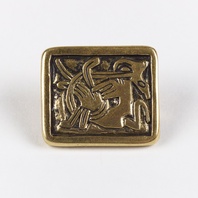
Viking Objects
Reproduction Square Mammen Brooch
This reproduction brooch is based on a small number of Mammen-style brooches found in England. Three rectangular brooches of this type are known from Linwood, Lincolnshire, West Stow Heath, Suffolk, and Bergh Apton, Norfolk, with further examples found in Cambridgeshire and East Anglia in 2015 and 2016. It is a type which has Carolingian-inspired shapes and Scandinavian decoration, which seem to have been produced in the Danelaw, and was an accessory for women who wore Scandinavian dress. Scandinavian brooches came in a variety of sizes and shapes which included disc, trefoil, lozenge, equal-armed, and oval shapes. The different brooch types served a variety of functions in Scandinavian female dress with oval brooches typically being used as shoulder clasps for apron-type dresses and the rest being used to secure an outer garment to an inner shift. Anglo-Saxon brooches do not match this diversity of form with large disc brooches being typical of ninth century dress styles with smaller ones becoming more popular in the later ninth and tenth centuries. However, since disc brooches were used by both Anglo-Saxon and Scandinavian women they are distinguished by their morphology. Scandinavian brooches were typically domed with a hollow back while Anglo-Saxon brooches were usually flat. Moreover, Anglo-Saxon brooches were worn singly without accompanying accessories.
Read More
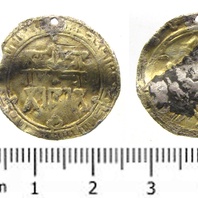
Viking Objects
Samanid Silver Dirham Pendant (LCNCC:2014.16)
An Arabic silver dirham minted c. 905-906 (Hijra 293) for the Samanid ruler, Isma’il ibn Ahmad (849-907), that has subsequently been pierced and gilded so that it could be worn as a pendant. It was probably minted in Balkh, Afghanistan. The Vikings often repurposed items like this. The dirham was a unit of weight used across North Africa, the Middle East, and Persia, with varying values which also referred to the type of coins used in the Middle East during the Viking Age. These coins were extremely prized possessions not only for their silver value but as a way of displaying one’s wealth and vast trade connections. Millions of Arabic dirhams would have been imported throughout the Viking world and are mostly found in hoards.
Read More
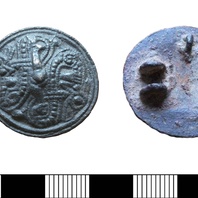
Viking Objects
Jellinge-Style Disc Brooch (LIN-F00E1B)
This Viking cast copper-alloy disc brooch is decorated with a Jellinge-style moulded zoomorphic motif comprising a knot of beaded lines. Brooches of this type are widespread in Scandinavia, with a particular concentration at Birka, the trading and military site in Sweden. For more information on Scandinavian jewellery in England check out our blog: Brooches, Pendants and Pins: Scandinavian Dress Accessories in England.
Read More
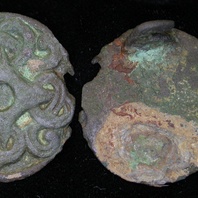
Viking Objects
Copper-Alloy Disc Brooch (LEIC-782CD2)
This Anglo-Scandinavian copper-alloy disc brooch has small traces of silvering on both surfaces. It is decorated in Borre-style interlaced knotwork matching the East Anglian type II. For more information on Scandinavian jewellery in England check out our blog: Brooches, Pendants and Pins: Scandinavian Dress Accessories in England.
Read More
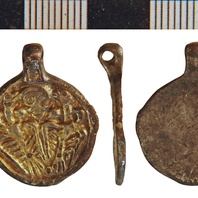
Viking Objects
Pendant with an Odin Motif (NLM-7F954A)
A cast silver, gilded pendant featuring an image which has been interpreted as representing the one-eyed god Odin and his two ravens Huginn and Muninn. There are a number of close parallels which establish the wide currency of this subject group. These include numerous examples from Russia and two from Sweden, including some with silver gilding. A silver pendant with a related, but distinct design is known from Sjælland, Denmark. With some exceptions, pendants were generally worn by women as part of their Scandinavian dress.
Read More
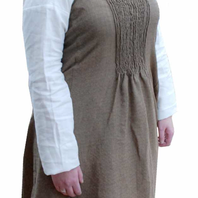
Viking Objects
Reproduction Women’s Clothing Set
The woollen strap-overdress is brown broken-diamond twill. A complete example of this dress has never been found, but this reconstruction is based on a composite of known archaeological finds. The narrow straps are often found mineralised inside the brooches, the pleated front section is based on an archaeological find from Køstrup, in Denmark, and the asymmetrical back panels are based on an original find from Hedeby, in Denmark. The underdress is of bleached linen, based largely on small traces of archaeological material from Birka, Sweden, Dura, Finland, and contemporary depictions. The woollen cloak is of thick yellow diamond twill with fringed edge. The vegetable-tanned leather toggled turnshoes are based on originals found during excavations at Coppergate, in York.
Read More
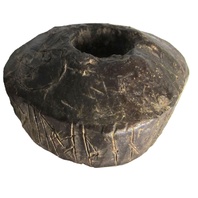
Viking Objects
Saltfleetby Spindle Whorl (LIN-D92A22)
A lead spindle whorl found at Saltfleetby St Clement, Lincolnshire, and inscribed with runes. The dating of the spindle whorl is uncertain, and dates in the late Viking Age, the early eleventh century, or even the twelfth century, have been suggested. The spindle whorl is inscribed with Scandinavian runes that appear to mention the Norse gods Odin and (possibly) Heimdall. The object is likely to have been produced locally, though the runes demonstrate contacts with the Scandinavian world of the time, perhaps especially Norway. John Hines has suggested the translation ‘Óðinn and Heimdallr and Þalfa, they are helping you, Úlfljót, and …’. For further discussion of the text, see the open-access article by Jesch referenced below. For more on runes, see our Runes page.
Read More
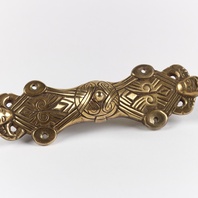
Viking Objects
Reproduction Equal-Armed Brooch
A reproduction of an equal-armed brooch in the Borre style found in Nottinghamshire. This style of brooch is known from Birka in Sweden, suggesting trade contacts or individuals from Birka arriving in the East Midlands. Brooches were a typical part of female dress. Scandinavian brooches came in a variety of sizes and shapes which included disc, trefoil, lozenge, equal-armed, and oval shapes. The different brooch types served a variety of functions in Scandinavian female dress with oval brooches typically being used as shoulder clasps for apron-type dresses and the rest being used to secure an outer garment to an inner shift. Anglo-Saxon brooches do not match this diversity of form with large disc brooches being typical of ninth century dress styles with smaller ones becoming more popular in the later ninth and tenth centuries. However, since disc brooches were used by both Anglo-Saxon and Scandinavian women they are distinguished by their morphology. Scandinavian brooches were typically domed with a hollow back while Anglo-Saxon brooches were usually flat. Moreover, Anglo-Saxon brooches were worn singly without accompanying accessories.
Read More
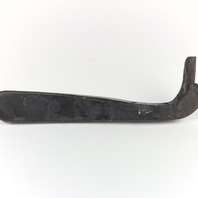
Viking Objects
Reproduction Iron Key
An iron key based on an original found in Grave 511 at Repton, Derbyshire. Iron keys were not only practical items but also symbols of status. Women were often given keys to the families chests of valuables. They also are often buried with keys, representing their authority in the household.
Read More
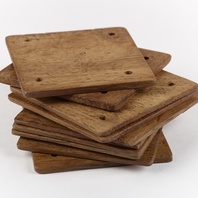
Viking Objects
Reproduction Weaving Tablets
Wooden weaving tablets for creating tablet-woven braids. These are based on examples found in the Oseberg ship burial.
Read More
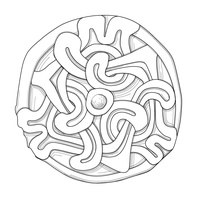
Viking Designs
Drawing of Copper Alloy Disc Brooch
Drawing of a copper alloy, gilded brooch with a zoomorphic design. Brooches were a typical part of female dress. Scandinavian brooches came in a variety of sizes and shapes which included disc, trefoil, lozenge, equal-armed, and oval shapes. The different brooch types served a variety of functions in Scandinavian female dress with oval brooches typically being used as shoulder clasps for apron-type dresses and the rest being used to secure an outer garment to an inner shift. Anglo-Saxon brooches do not match this diversity of form with large disc brooches being typical of ninth century dress styles with smaller ones becoming more popular in the later ninth and tenth centuries. However, since disc brooches were used by both Anglo-Saxon and Scandinavian women they are distinguished by their morphology. Scandinavian brooches were typically domed with a hollow back while Anglo-Saxon brooches were usually flat. Moreover, Anglo-Saxon brooches were worn singly without accompanying accessories.
